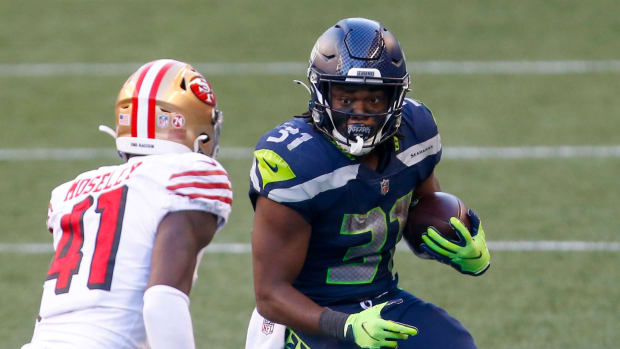Seahawks Offseason Profile: Jacob Hollister
Following two unproductive, injury-riddled seasons with the Patriots, tight end Jacob Hollister was acquired by the Seahawks last spring in exchange for a seventh-round selection in this month’s NFL draft.
Heading into the 2019 season, Hollister was expected to be mainly featured on special teams and opened the year on Seattle's practice squad. But after Will Dissly suffered a season-ending Achilles injury in Week 6, the third-year pro took over the starting job and became a pleasant surprise for the Seahawks.
Let’s revisit some of the good and the bad from Hollister’s third NFL season, along with a prediction of how next season may play out for him after receiving a second-round tender as a restricted free agent.
What Went Right
While Hollister didn’t receive a single offensive snap until Week 6, the 6-foot-4 tight end found his footing with his two touchdown performance against Tampa Bay in Week 9.
Overall, the Wyoming graduate played in 11 regular season games and produced 41 catches, 349 receiving yards, and a 69.5 percent catch rate (eighth-highest among all tight ends with at least 40 receptions). He scored three touchdowns and averaged 8.5 yards per catch, according to Pro-Football-Reference.com.
During Hollister’s two seasons with the Patriots, he wasn’t provided with many opportunities to create yardage after the catch. However, that trend didn’t continue for him in Seattle during the 2019 campaign.
Among all tight ends with 60 targets or fewer, the 26-year old finished tied with the fifth-most yards after catch (182) and the sixth-most broken tackles (three), according to Sports-Info-Solutions.com.
For Hollister, a large part of the success he had in 2019 should be credited to the amount of separation he was able to create against coverage during this past season.
In total, the Seahawks’ tight end averaged 6.8 yards of cushion off the line of scrimmage (most among all tight ends in the league with at least 43 targets). As a result, he finished the 2019 campaign tied with the sixth-most average yards of separation (3.5), according to Next-Gen-Stats.com.
Along with Hollister’s impressive results as a receiver, he was also surprisingly effective as a blocker when called upon.
During his 130 rushing snaps, Hollister finished tied with the fourth-fewest number of blown blocks (one) among all tight ends with at least 100 run blocking snaps. Among all tight ends with at least 40 passing snaps, he finished this past season tied with the eighth-fewest blown blocks (one).
What Went Wrong
For the most part, Hollister was pleasantly productive during his opening season with the Seahawks. But, he did become stagnant at times in the passing game throughout the 2019 campaign.
Despite producing at least four receptions and 30 receiving yards through five of his eleven games, Hollister recorded three catches or fewer along with 25 yards or less in four contests during this past season.
Furthermore, these struggles continued for the Oregon native during Seattle’s first playoff game against Philadelphia. While Hollister was on the field for 88 percent of the offensive snaps, he caught just a pair of passes for 16 yards.
While Hollister caught five of his six targets for 47 yards in Seattle’s second playoff matchup in Green Bay, his woes during the postseason continued as he nearly lost his first career fumble and dropped a key third down pass from Russell Wilson that would've moved the chains for a first down.
In addition, penalties started to become a major issue during the playoffs for the young tight end. After committing just a single penalty in the regular season, Hollister was flagged for a pair of false start penalties and an offensive pass interference call during the opening round of the postseason.
2020 Outlook
Heading into next season, if it starts on time, there’s a good chance that Hollister won’t see the field as much in 2020, though there still should be a role for him due to his different skill set from the rest of the tight end group.
With Greg Olsen and Dissly expected to be ready by Week 1, they’ll both likely command a large chunk of the playing time for Seattle offensively. As a result, Hollister will probably be limited to just special teams and a reserve role as a move tight end.
In comparison to Hollister’s first three seasons in the league, there have been 15 other tight ends who’ve produced at least 40 receptions and three touchdowns along with 450 yards or fewer through their first three seasons in the NFL.
Among all the players listed above, only six of them recorded at least 20 receptions, 200 receiving yards, and one touchdown during their fourth season in the league. In addition, only Bob Moore and Mark Campbell caught at least 30 passes for a minimum of 300 yards in their fourth year in the NFL.
Based on these results, it appears it would be very difficult for Hollister to replicate his production from the 2019 campaign, even if he was given the starting job somehow. But with Olsen and Dissly having lengthy injury histories, it's not out of the question he could wind up playing quite a bit even in a reserve role.




